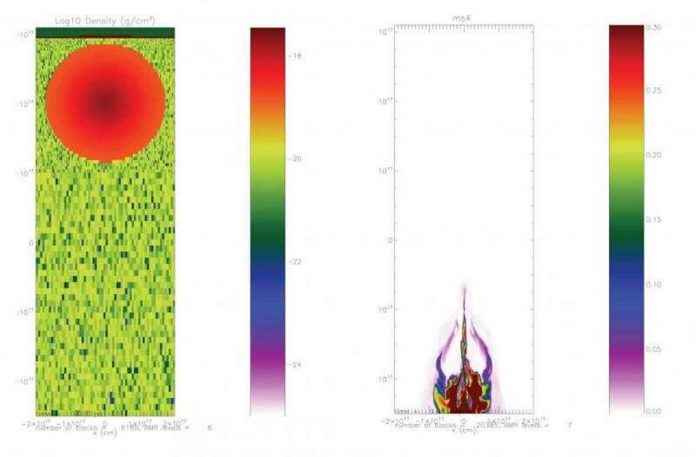According to new research published in The Astrophysical Journal by Carnegie’s Alan Boss, the violent event that likely preceded the formation of our solar system holds the key to solving a long-standing meteorite mystery.
When the shock wave from an exploding supernova injected material into a cloud of dust and gas, causing it to collapse in on itself, the raw material from which our solar system was built was dispersed. Following this event, the majority of the injected matter was gravitationally drawn into the centre of the whirlwind, where the intense buildup of pressure allowed nuclear fusion to begin and the sun to be born.The young star was surrounded by a rotating disc of the remaining gas and dust, from which planets and other solar system bodies coalesced, some of which broke up to form asteroids and meteorites.
“The mystery is revealed by studying the isotopic composition of meteorites, which can be used as a laboratory to test theories of solar system formation and evolution,” explains Boss.
Isotopes are elements that have the same number of protons but different numbers of neutrons. When it comes to radioactive isotopes, the number of neutrons in the nucleus can sometimes make the isotope unstable. To achieve stability, the isotope emits energetic particles, which change the number of protons and neutrons, causing it to transmute into another element known as a daughter isotope.
“Because we know how long this process takes for different radioactive isotopes, measuring the amount of daughter products in meteorites can tell us when, and possibly how, they formed,” Boss added.
For example, the iron isotope with an atomic weight of 60 is only produced in significant quantities by a supernova explosion, and it takes 2.6 million years for half of the atoms to decay to its daughter isotope, cobalt-60, a process known as “half-life.” When significant amounts of cobalt-60 are discovered in primitive meteorites known as carbonaceous chondrites, researchers know that the raw material from which the chondrite was formed contained remnants of a supernova explosion that occurred just a few million years before its formation.
The chondrite record can be used to confirm our solar system’s supernova origin story. Other, less primitive, non-carbonaceous meteorites, on the other hand, lack this iron-60 composition, indicating that the material from which they formed did not come from a stellar explosion. So, how did it get there? “No physical explanation for this dramatic change has been offered,” Boss said.
For several decades, he has been honing sophisticated models of our solar system’s formation and was one of the originators of the supernova injection origin story. He was able to demonstrate that after triggering the collapse that supplied the chondrites with iron-60, the supernova’s shock front sweeps away the interstellar dust beyond the resulting disc and accelerates the resulting protostar to a speed of several kilometers per second by extending the time period reflected in his simulations. Within a million years, the young sun will encounter a new patch of interstellar material depleted in iron-60 and other supernova-generated isotopes.
“It was amazing to finally be able to link this model to the meteoric evidence after working on the problem of supernova triggering and injection since the mid-1990s,” Boss concluded. “It neatly concludes this story.”

